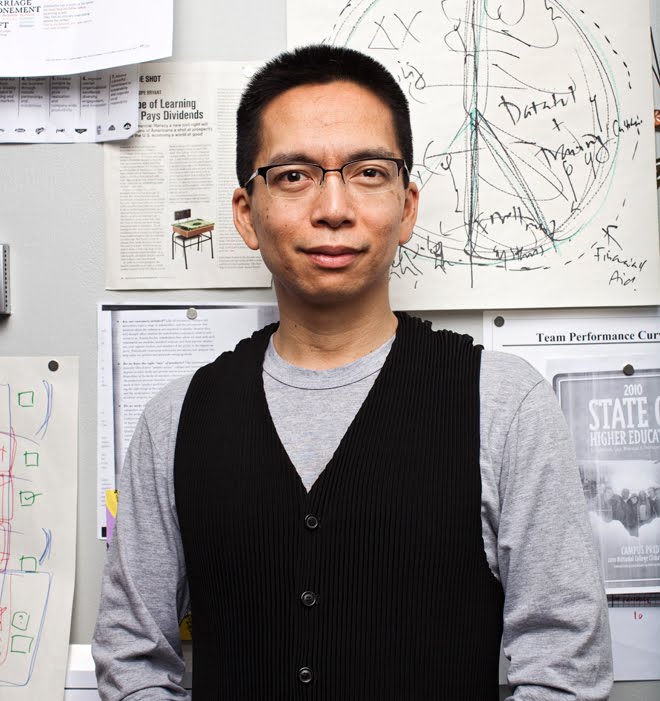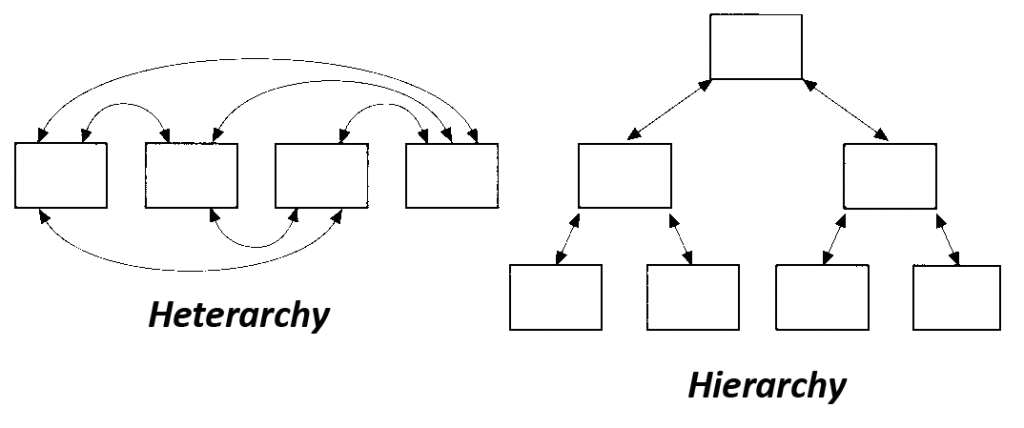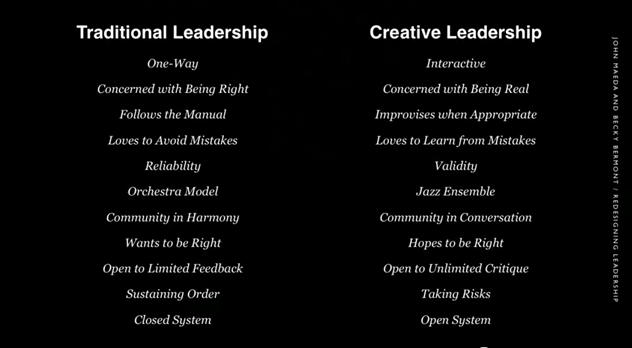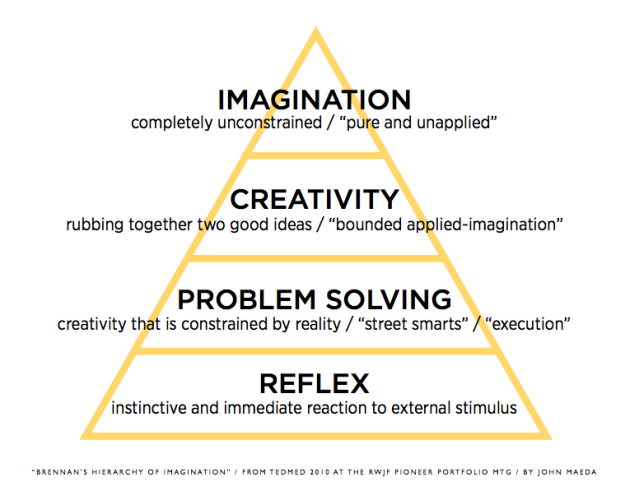
John Maeda – creative leader par excellence (courtesy of Wired.com)
In the age of rapidly changing consumer tastes, ubiquitous digital connectivity and ever changing socio-cultural dynamics, the old ways of leadership will no longer work.
To survive and thrive in this tumultuous age, organisations need to be innovative, open, collaborative and flexible.
We need to marry art, design and technology when asking questions, providing solutions and creating possibilities.
However, who should lead us in this brave new world? One where the speed of technological and social changes often leave us breathless, trying to catch up with the next wave.
Enter the Creative Leader
Change making and transformative, a creative leader is an icon of imaginative influence.
According to Jeffrey Zacko Smith and colleagues from Buffalo State College, creative leaders are identified by…
“The ability to deliberately engage one’s imagination to define and guide a group towards a novel goal — a direction that is new for the group. As a consequence of bringing about this creative change, creative leaders have a profoundly positive influence on their contexts (workplace, community, school, family, etc.) and the individuals in that situation.” – Jeffrey Zacko Smith
From the description above, we see that creative leaders are influencers with an uncanny ability to trigger their follower’s creativity and imagination.
Heterarchies – a peer-to-peer organisational model
Before we dive deeper into creative leadership, let us first understand how organisations are evolving.
In the social age, traditional hierarchical organisations will morph into heterarchical ones. Instead of having every worker managed by another above them like a pyramid, heterarchies are peer-to-peer systems. Here, decisions are often made in-situ, across different cross-functional teams.
Unlike traditional organisations, the CEO is no longer at the top of the “food chain” in a heterarchy. Instead, he or she is in the nexus of the “ecosystem”.
Catalysed by external and internal social networks, the organisation of the future will be more fluid, dynamic and fast moving.
This can be viewed simplistically as follows:

Courtesy of Brian Watkins
Traditional versus Creative Leadership
With the above changes, traditional leadership approaches are no longer as effective nor efficient.
According to John Maeda, president of the Rhode Island School of Design, the heterarchical organisations of the future require creative leaders who are interactive, improvisational, risk taking, open and real.
Creative leaders work alongside their team members, and are transparent about their mistakes. They are also far more willing to take calculated risks, and to encourage their team members to critique and even challenge their ideas.
Often, the way they manage is more akin to a jazz ensembles rather than a traditional orchestra. Ideas and decisions are free-flowing, improvisational and adaptive.
A good way to view the differences between traditional and creative leadership is presented by the table below.

Image courtesy of Emily Carr University of Art + Design
Growing your Creative Leadership Quotient
OK, so we realise how our old dictatorial style of leadership is outmoded in the creative age. What then can we do to up our creative leadership quotient?
Maeda proposes six principles which I’ll go through in turn:
1. Build From Foundations
Emphasise the core skills of your colleagues. In the case of Maeda’s organisation, this would include artistic and design skills like sketching, drawing and examining raw data in whatever forms.
Note that this isn’t about going back to school or revisiting the past, but to help one’s team – and oneself – to achieve rigour and competence in vital fundamental skills.
2. Craft The Team
Collaborate and work actively with your people to build the organisation. Work together with them and not above them.
Be available on the ground, roll up your sleeves, and “lead from the trenches”. When push comes to shove, do not hesitate to be the one to step forward to take the flack.
This helps leaders to inspire others while deepening his/her ability to sense ground sentiments.
3. Sense Actively
Be attuned to the feelings of others. A creative leader is one whose ear, feet and heart is constantly on the ground. He or she is closely attuned to the emotional balance and group dynamics of his team.
Don’t lock yourself behind ivory towers. Instead, make special efforts to foster active relationships and show genuine concern for your colleagues in an open and transparent environment.
4. Take Leaps
With reference to Patti Brennan’s “Hierarchy of Imagination” (see below), creative leaders should emulate artists by taking risks and questioning why things are done a certain way.
Patti Brennan’s Hierarchy of Imagination (courtesy of Creative Leadership)
Instead of relying on tried-and-tested solutions to problems, creative leaders should activate their imagination to look for unconventional approaches to solutions. They should also have considerable flexible and reflexive management skills to adapt to an ever-evolving landscape.
This method of leading may inevitably lead to some degree of chaos and messiness in the process. It may also result in potential conflicts when ad-hoc unplanned for initiatives collide with the game plan. To avoid this, a creative leader needs to apply his or her heart to listen to what the team is saying.
5. Fail Productively
The principle of “fail fast, fail safe, and fail often” isn’t new. This dictum certainly applies in any creative leadership endeavour.
Failing productively means looking at how organisations can bounce back quickly from mistakes without disabling their core businesses. Having a resilient culture also helps organisations to stay focused to their objectives and be united come hell or high water. This is absolutely necessary in the tumultuous waters of today’s creative industries.
6. Grow From Critique
Last but certainly not least, creative leaders need to have thick skins that can handle negative feedback. Criticism is a key strength in creative organisations as it bolsters intellectual leadership while allowing teams to learn quickly.
Being able to speak candidly without fear of repercussion is certainly key in such organisations. Here, creative leaders can play significant roles by not just allowing open but respectful critique, but encourage their team members to also challenge their ideas.
Do You Know a Creative Leader?
As I ponder over the various values and attributes of a creative leader, I reflected upon some of the CEOs and bosses whom I’ve worked with. While some of them would certainly qualify as being “creative” or “imaginative”, they usually revert back to traditional top-down leadership styles in the face of challenges. This may perhaps be necessary, given that hierarchical leadership is often a trait of Asian leaders regardless of the size of their organisations.
What are your thoughts on creative leadership? Are there any examples that you can think of?


thanks for share.